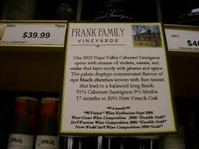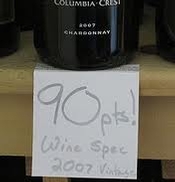The value of wine ratings, particularly those that provide numerical scores based upon the 100-point scale, is a frequent subject of debate among those who critically evaluate new wine releases and make recommendations to consumers.
In recent years, there has been a loud, and sometimes vulgar, attempt to discredit the 100-point scale, which is used by WRO and virtually all of the major wine publications to provide an easy-to-understand quantification of wine quality. You don’t have to be a master sommelier to figure out that a reviewer gave the wine an A+ grade if it was assigned a score of 95 points or higher.
 This system has served the consumer well over the 30 years or so since it was introduced by one of the wine mags, and popularized by the infamous wine critic, Robert Parker.
This system has served the consumer well over the 30 years or so since it was introduced by one of the wine mags, and popularized by the infamous wine critic, Robert Parker.
Still, there are those who loathe it for a variety of reasons. The most oft-repeated criticism is that it is impossible to assign a number to a bottle of wine. What is the difference, the argument goes, between an 88-point wine and a 92-point wine? Who could possibly be that precise?
Indeed, how do we explain that WRO assigned a 92-point score when a popular wine magazine gave the same wine 88 points? Which is it? This gets to my personal point of view that the score is merely a measure of a specific wine critic’s enthusiasm for the wine being reviewed.
What’s important is that the critic is consistent and can repeat the analysis in a blind tasting. So it was gratifying to me that when, earlier this year, I was given the same wines twice while tasting "blind" at the Concours Mondial de Bruxelles, the world’s largest international wine competition, I was able to virtually repeat my score on the two wines used to test my "repeatability."
The Concours Mondial just so happens to use the 100-point scale. I gave the first wine that was put to me twice a score of 86, then followed with an 87 when, unbeknownst to me, it was presented a second time. The second wine rated an 89-point score on the first tasting; 90 points when it came around again.
The results of the repeatability test only strengthened my resolve to resist the pressure from some quarters to renounce the 100-point scale in favor of what I consider a bland format that lumps wines inside broad, non-controversial categories such as "recommended" or "highly recommended." To me, that’s a wimpy, gutless option.
When I tag a wine 97 points, on the other hand, it’s a bold statement certain to get your attention. And it leaves no doubt that I’m crazy about the wine.
Over the years, whether speaking to consumers at a public tasting or simply making generalized wine suggestions around the holidays, I’ve learned there is one question that is paramount when I’ve thrown out a bevy of suggestions: Which wine do I like best?
The 100-point scale is the most precise tool for sorting out those levels of preference.
 The reason that is so important is because most wine drinkers are not hip to every new wine that comes along; and there are literally millions of new wine releases every vintage. The options can be overwhelming even for those who have the energy and time to attend tastings and do the research. The average person is more than happy to let someone else do the homework and issue a grade, or score, that can be used as a guide when shopping, particularly in a venue that provides a vast selection and little assistance from knowledgeable staff.
The reason that is so important is because most wine drinkers are not hip to every new wine that comes along; and there are literally millions of new wine releases every vintage. The options can be overwhelming even for those who have the energy and time to attend tastings and do the research. The average person is more than happy to let someone else do the homework and issue a grade, or score, that can be used as a guide when shopping, particularly in a venue that provides a vast selection and little assistance from knowledgeable staff.
I was appalled recently when a colleague who opposes the 100-point scale tweeted words to the effect that anyone who would buy a wine based upon a numerical rating is a troglodyte.
No, I believe the caveman in the crowd is the person so steeped in the wine-geek’s view of the world that he or she would begrudge ordinary folk this simple tool that cuts through all the pretentious and often confusing wine-speak you will find in most wine reviews, including my own.
8
